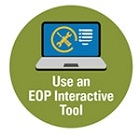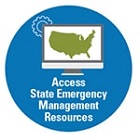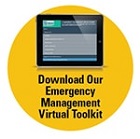|

Earthquake Preparedness for K-12 Schools and
School Districts
An earthquake is caused by the sudden slip on a fault and the resulting radiated seismic energy; volcanic or magmatic activity; or other sudden stress changes in the Earth. These can result in effects such as ground shaking, soil liquefaction, and ground failure. Generally, an earthquake can occur almost anywhere in the United States, at any time of year, and at any time of the day or night. According to the U.S. Geological Survey, “42 states have a reasonable chance of experiencing
damaging ground shaking from an earthquake.”1 Review the
frequency of damaging earthquake shaking around the U.S.
and earthquake
information by your state/territory.
Earthquakes are one type of natural hazard that may impact K-12 schools and school districts, making earthquake planning an important part of school safety, security, emergency management, and preparedness. Does your whole school community know how to
“Drop, Cover, and Hold On”
and respond in the event of an earthquake? Does your school or school district conduct nonstructural and structural mitigation of all school buildings? Does your school or school district provide training on personal protection,
Teen Community Emergency Response Teams,
the
National Incident Management System,
and/or the
Incident Command System?
Does your school or school district have a plan that addresses physical and structural recovery; academics recovery; business services recovery; and health, social, emotional, and behavioral recovery?
Creating an Earthquake Annex
Schools and school districts can prepare for earthquakes, including cascading or secondary effects, by developing an Earthquake Annex, as recommended by the
Guide for Developing High-Quality School Emergency Operations Plans
and
The Role of Districts in Developing High-Quality School Emergency Operations Plans.
The Earthquake Annex is part of the Threat- and Hazard-Specific Annexes section of a school emergency operations plan (EOP), and should outline goals, objectives, and courses of action for members of the whole school community to take before, during, and after a possible earthquake. Developed using the six-step planning process, an Earthquake Annex serves as a key tool for the whole school community to prepare for, prevent against, mitigate, respond to, and recover from earthquakes. Core planning teams should develop, as well as regularly review and revise, their Earthquake Annexes in collaboration with community partners, including architects, engineers, city planners, fire officials, search and rescue, local/state seismologists, geologists, etc.
Review the REMS TA Center’s
Sample Earthquake Annex
to get a sense of the potential structure and contents it could include. Plans should always be customized to the building level and take into consideration each school’s unique circumstances and resources.
NEW Online Course
To support K-12 schools and school districts with learning more about the risks posed by earthquakes and developing an Earthquake Annex, the REMS TA Center has created a NEW online course, entitled Earthquake Preparedness for K-12 Schools and School Districts. Through engaging visual content and interactive quizzes, this online course
- Introduces the causes, characteristics, and impacts of earthquakes;
- Shares strategies and considerations for comprehensively planning for earthquakes;
- Walks through how to develop an Earthquake Annex customized to your school using the six-step planning process; and
- Discusses other relevant EOP annexes that may be activated in the event of an earthquake.
This asynchronous training opportunity is recommended for members of core planning teams, as well as school, school district, and community partner personnel with a role and/or responsibility in school safety, security, emergency management, and preparedness.
Additional Resources
In addition to this new online course, the REMS TA Center and its partners offer the following resources to support K-12 schools and school districts in preparing for earthquakes and developing an Earthquake Annex.
1“Natural Hazards of 2014.” U.S. Geological Survey, 15 Jan 2015, https://www.usgs.gov/news/featured-story/natural-hazards-2014. Accessed 17 Mar 2022.
|










